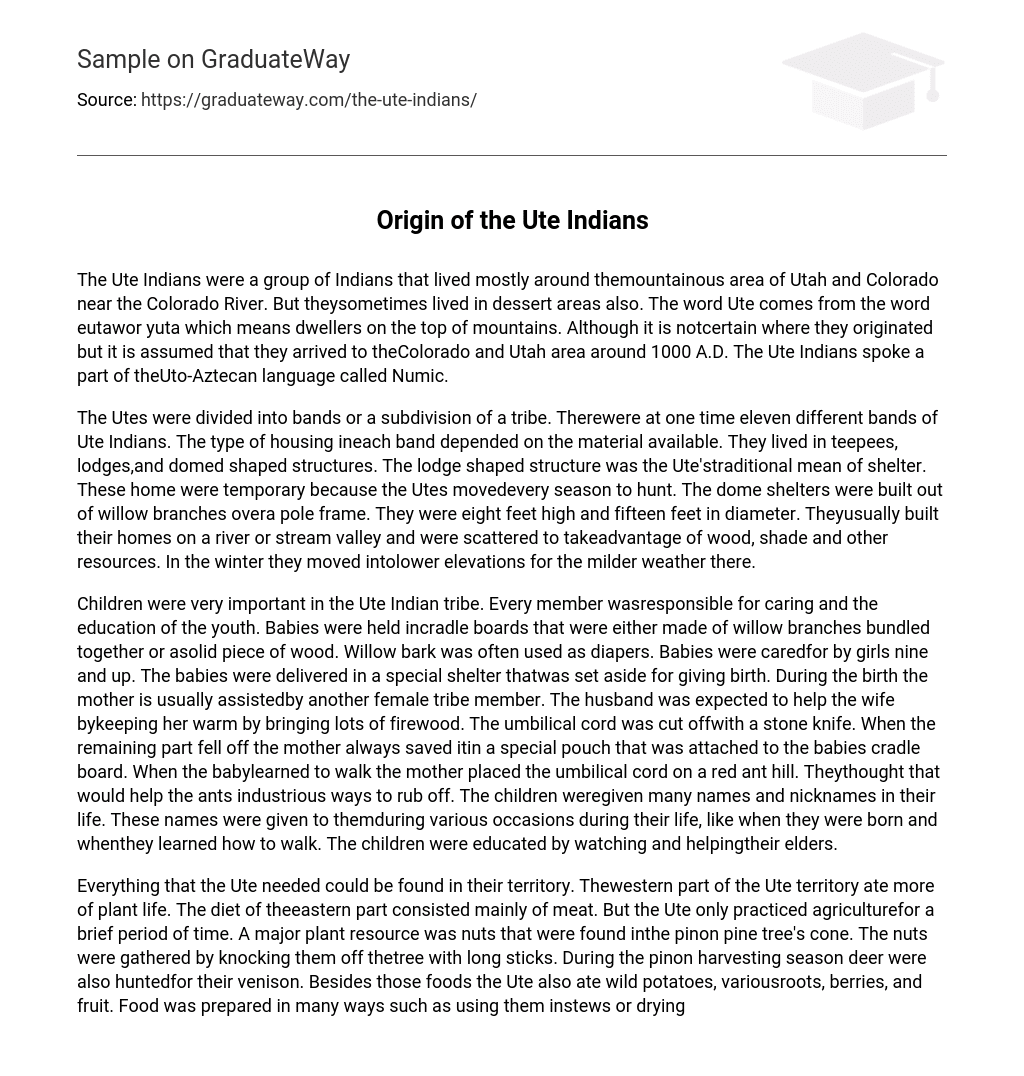The Ute Indians were a Native American group residing in the mountainous regions of Utah and Colorado, near the Colorado River. They also occupied desert areas at times. The term “Ute” derives from “eutawor” or “yuta,” meaning “dwellers on the top of mountains.” While their exact origins are uncertain, it is believed that they migrated to the Colorado and Utah area around 1000 A.D. The Ute Indians spoke a dialect of the Uto-Aztecan language known as Numic.
The Ute Indians were divided into bands, with at one point there being eleven different bands. The type of housing used by each band varied depending on the available materials, with teepees, lodges, and domed shaped structures being common. The lodge shaped structure, in particular, was the traditional shelter of the Utes. However, these houses were temporary as the Utes would move each season for hunting purposes. The dome shelters were constructed using willow branches over a pole frame and measured eight feet in height and fifteen feet in diameter. Usually, the Utes would build their homes in river or stream valleys, strategically scattered to utilize wood, shade, and other resources. During winter, they would relocate to lower elevations for milder weather.
Children held great importance within the Ute Indian tribe, with every member being responsible for their care and education. Cradle boards made from willow branches or solid wood were used to hold babies, while willow bark served as diapers. Girls aged nine and older were entrusted with the task of caring for the infants. A designated shelter was reserved for delivering babies, usually with assistance from another female tribe member. The husband’s role included keeping the wife warm by supplying ample firewood. Cutting off the umbilical cord involved using a stone knife, after which the mother would store the remaining piece in a pouch attached to the baby’s cradle board. To aid their transition into walking, the mother would place the umbilical cord on a red ant hill, believing it would inspire the diligent ants to rub it off. Throughout their lives, children received numerous names and nicknames on different occasions, such as their birth or when they started walking. The elders served as teachers, with the children learning through observation and participation.
Everything the Ute needed could be sourced within their territory. The western part relied more on plant life, while the eastern part predominantly consumed meat. Although the Ute briefly practiced agriculture, they primarily relied on nuts from the pinon pine tree’s cones as a key plant resource. These nuts were gathered by using long sticks to knock them off the tree. During pinon harvesting season, the Ute also hunted deer to obtain venison. In addition to these foods, the Ute consumed wild potatoes, various roots, berries, and fruit. They prepared food in multiple ways, including using them in stews or drying them for winter. Occasionally, crickets and grasshoppers were added to stews for extra flavor. The Ute also cultivated tobacco for religious ceremonies and tribal customs.
Men played a role in hunting as well as assisting with gathering berries and nuts. The Ute tribe engaged in hunting and fishing a diverse range of prey, including buffalo, elk, whitetail deer, mule deer, antelope, mountain sheep, moose, jackrabbits, and cottontail rabbits. They also pursued birds and various types of insects. The predominant hunting tool for the Ute tribe was the bow and arrow. They utilized two types of bows: wooden bows and horn bows. The wooden bows were elongated and slender pieces of wood.
The horn bows were crafted from the horns of mountain sheep. After splitting and shaping them, sinew was wrapped around to enhance their durability. The arrows measured approximately two feet in length, featuring a fire-hardened tip and a stone point.
When fishing, the Cree used two methods: spearing the fish or shooting them with a special barbed arrow. During the winter, they built shelters on frozen lakes and cut holes in the ice for fishing.
The Ute people wore simple clothing, but some of their garments were embellished with beads and patterns. The men typically donned deerskin breechcloths or leggings.
When it was colder, the Ute people would wear a deerskin shirt. For footwear, they would wear moccasins or sandals. Women would dress in skirts or long dresses made out of deerskin woven with bark or reeds. Additionally, the Ute people enjoyed wearing jewelry, such as small polished bones in their noses and necklaces made of animal claws, bone beads, stones, and occasionally seeds. During special events, they would adorn their faces with white, black, red, blue, or green face paints.
The Ute Native Americans engaged in recreational activities in addition to their daily responsibilities. They enjoyed games such as dice, where specific symbols determined the outcome. Additionally, they participated in gaming activities resembling baseball and kickball. A popular game among Ute men involved rolling a hoop in front of a player equipped with darts, with the objective of throwing the darts into the center of the hoop.
Currently, there are approximately seven thousand Utes who continue to reside in the Colorado and Utah region. Several reservations exist in this area. These remaining Utes face challenges such as unemployment and alcohol abuse, primarily stemming from limited education and skills training. However, the Ute reservation has recently established a casino, offering job opportunities to many Utes. This not only improves their quality of life but also provides them with a more promising future.





